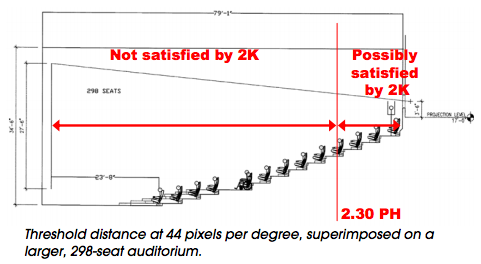Digital film distribution in the UK
The physical distribution and exhibition of movies in UK cinemas has changed hugely in the last five years. The 125-year-old era of 35mm celluloid film is over, giving way to a digital future. Here are some of the key facts to stay up to speed with the recent changes in UK cinema exhibition...

35mm distribution may end this year
Fortunately 92% of UK cinema screens are digital
And 41% are equipped with 3D
You only need 2k resolution for nearly all screens
4k resolution is not always better than 2k
But screening at 4k can lead to better reviews
Vue have the most 4k screens in Europe
4k storage is 11 times more expensive than 35mm film
Bonus fact: The best cinema seats are 1.5 times the height of the screen away from the screen with a viewing angle of 37 degrees
35mm distribution may end this year

The peak for celluloid distribution was 2008 when over 13 billion feet of film were used worldwide. By 2012 that number had dropped to below 4 billion feet and it's days are seriously numbered. Believe it or not the Hollywood studios are not the biggest factor in deciding when digital film distribution takes over. The two major film stock suppliers have been hit hard by the recent trend to digital exhibition - Fuji stopped producing new 35mm film in April this year and Kodak is going through a long bankruptcy procedure in the US. Whether or not Kodak continue to produce 35mm stock will be down to the US Court handling the liquidation.
Fortunately 92 percent of UK screens are digital
The vast majority of UK cinema screens are digital, way above the worldwide average (54%) and better even than American and China (both 70%). However we're behind Norway and Luxembourg who were the first countries to go completely digital.
The UK has a high proportion of digital cinema screens, thanks in part to a collaboration between the UK Film Council and the Arts Council called the 'Digital Screen Network'. They spent £12million helping 210 cinemas add digital screens to their sites, which account for almost a third of all cinemas.
And 41 percent are equipped with digital 3D
In 2006 only 5 screens in the UK were equipped to digitally project 3D. This grew rapidly until 2011 when 39% of screens were ready for 3D. Since then there has been a marked slowdown in the 3D boom, possibly due to the worsening performance of 3D films at the box office.
You only need 2k resolution for nearly all screens
The resolution is a measurement of the width of the images in pixels. "2k" is 2048 pixels wide and 1080 pixels high whereas "4k" is 4096 wide by 2160 high. The first batch of commercial digital projectors in European cinemas operated on a resolution of just 1.3k but now the vast majority operate at 2k (20,665 cinema screens, representing 93.3% of the market).
4k resolution is not always better than 2k
4k cinema has four times the number of pixels as 2k cinema - mathematically it wins hands down. But a Sony report from last year suggests that it's not maths that matters - it's comfort. That's an interesting finding not least because Sony have a large vested interested in 4k as they are a major supplier of 4k projecting equipment. Their report, entitled “Does 4K really make a difference?” found that whether or not the audience could tell the difference came down to a variety of factors including where they're sat, the size of the screen, the size of the cinema and, possibly most crucially, the audiences' eyesight!
But screening at 4k can lead to better reviews
When the audience were sitting in a position in which there was a visual difference between 4k and 2k they found that the audience thought the movie was better in every way they were asked. This included
"This is something I would tell my friends about"
"This is worth paying more for"
"I would go out of my way to go to a theater that offered this type of picture quality"
It also matters how the film was shot and post-produced. A 4k projection of a movie shot (or finished) at 2k then upscaled 4k will have little benefit to audiences.
Vue have the most 4k screens in Europe for digital film distribution

Vue cinemas have a network of 650 4k digital screens across 69 cinemas in the UK and Ireland. Films that have been released in 4k include 'Skyfall', 'After Earth', 'Argo' and 'Elysium'.
4k storage costs 11 times more than 35mm film
A 2007 study by the Academy of Motion Picture Arts and Sciences found that it was 11 times more expensive to store films at 4k resolution than storing traditional 35mm negatives. One would expect this cost to fall as hard drive space becomes ever-cheaper. They also pointed out that properly stored film is guaranteed to last 100 years where as no current form of hard drives or optical media can be relied upon over the same time period.
Bonus Fact: Where to sit in the cinema
If you were wondering where you should sit on your next trip to the cinema, then fear not; the Sony report I cited above also figured that out:
The most desired seats for the most enthusiastic ticket holders are roughly 1.5 Picture Heights from the screen. At this distance the viewing angle is 37 degrees. The relaxed reference of 44 pixels per degree multiplied by 37 degrees vertical equals 1628 pixels vertical.

All I need now is an iPhone app that calculates this for me for every cinema in the UK.


